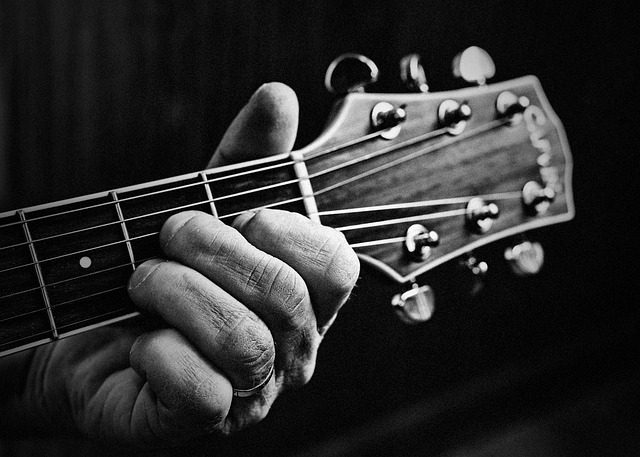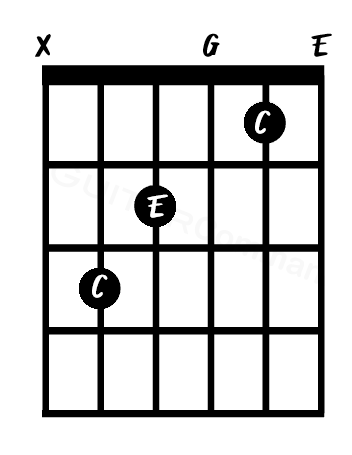It takes practice and persistence, but you can get to the place where you never have to ask someone “what chord is this?” again.

Everyone has asked that question
The question comes up surprisingly often. In fact, I think it safe to say that virtually everyone who attempts to learn the guitar and other chording instruments asks it. And probably more than once.
No shame exists in asking, but wouldn’t it be great to never have to again? Asking it is admitting that you don’t really know your instrument, and no one wants that!
Wonder if you could answer for yourself so that you never have to ask out loud again? Better yet, wonder if you could be the one to answer when someone else asks? Now that’s a fun position to be in!
It’s more than a dream–you can answer it
As much as it seems only the mythical power of the biggest music brains can answer such deeply theoretical musical questions, even mere mortals like you and me can posses that ability.
In fact, the ability to answer that question is easily within your grasp. You really just need to know a bit about what makes a chord.
What makes a chord?
As I discussed in my article It’s easier than you think to learn how to play a chord on guitar, every chord has a recipe. In fact, in an even broader sense, every type of chord has a distinct recipe. And all other chords of the same type follow the same recipe.
So, for instance, among the simplest chords, we have the major chords. And all 12 major chords have the same makeup.
To form a major chord, you only need play the first, third, and fifth notes of the major scale. I’ll go into more detail on this in a future post, but for now, that simple recipe serves well for this discussion.
And this doesn’t apply to only major chords. Minor chords have a distinct recipe. Major Seventh chords have a distinct recipe. Even the potentially mythical minor/major nine add six add 11 flat 13 augmented 11/two chord has a recipe. Honestly, I got that from a Google search and I don’t know if such a thing actually exists…but I don’t doubt it!
So as not to get off the point, just remember that as the first step toward answering the question, you need to understand how to construct chords. And understand that every type follows a specific recipe.
Two ways to identify a chord
OK; so now that we know that, how do you actually go about answering the question and identifying a chord?
Well, as with many things in life, we can identify a simple approach. In fact, we have two possible approaches.
First, you can look at a chord either on the instrument or in a diagram. Then you can use your knowledge of chord recipes to find the answer to identify it.
And second, you can use your ear to identify the notes in the chord. Then combine that with your knowledge of chord structure.
Identify a chord by sight
Start with the easier of the two approaches: identify the chord by sight. This means that you can look at a diagram or even look at the fingers to see how they make the chord.
Again, for example, let’s take that simple major chord. Say you grab your guitar and make a shape with your fingers so that the notes you play are C, E, and G. It might look like this diagram.

Now here’s where you need to understand chord recipes. And you also need to know a bit about the major scale and scale degrees. Check out my articles on those two topics if you need help.
You look to see the notes being played are C, E, and G, and with your knowledge of chord structure and the major scale, you can easily identify the chord as C major.
To understand why, look at the C major scale. The first degree of the scale–the root note-is C. The third, E. And the fifth note, G.
Identify a chord by sound
The second method takes a lot of work for some of us. I have met musicians that can hear a chord and nearly instantly identify it. Worse yet, that ability is natural for them. They didn’t have to work for it. I am not one of those musicians! And you shouldn’t panic if you aren’t either.
As impossible as it might seem, you can develop the ability to pick notes out by ear. Even if you were not born with it. The task presents more of a challenge to some of us than others. I need to continually work to develop my own ability.
This type of “ear training” takes a lot of work for some of us, but the effort pays dividends. Only you can decide whether to put in the time and effort to develop your ear, but I can virtually guarantee that you won’t wish you hadn’t spent that time. The ability to hear music that way opens up so many possibilities for you that its benefits cannot be overstated.
Once you have that ability, your knowledge of chord recipes and structure kicks in just as when you identified notes by sight.
What if the notes are in a different order?
Great. So you always take the first note you find and that’s the root note. Then if the the next two notes are the three and the five, you have a major chord, right?
Almost right. It doesn’t matter what order the notes are in. For instance, with the lowest note C, the middle note E, and the highest not G, you have a major chord. That’s true. But the order doesn’t matter.
If you have the lowest note an E, the middle note a G, and the highest note a C, you still have a C major chord. We call such a case an inversion and that’s another topic I can write about later.
In fact, another inversion exists too. With the lowest note G, the middle note C, and the highest note E, you still have a C major chord.
In other words, order doesn’t matter. The one, three, and five played together in any combination makes a major chord.
But wait; some chords have more than three notes
So true. What happens when you find a chord with four, five, or even six notes in it? Well, you can still find the answer. It just takes a little more work and and bit more knowledge.
A couple things could be going on. First, maybe the extra notes simply repeat one of the three notes in the major chord. This happens on guitar all the time.
For instance, the standard C major chord shape on guitar uses five strings. But it only contains three notes. Two of the notes simply repeat in higher octaves, as you see in this diagram.

So, you play five strings, but only three notes. And many of the other major chords do the same thing. So you still have a major chord.
The second possibility occurs when one or more different notes exist in the chord. In that case, you no longer have a simple major chord. So what chord is this?
In short, you just need to figure out what scale degree the note occupies in order to answer the question. As a simple example, if you have the notes of the C major chord, and you add the seventh note of the C major scale (the note B), then you have the chord C Major Seventh.
Are some of these terms confusing you? Download my glossary of music terms so you’re never lost again!

Things can quickly get more complicated, but the basic idea remains the same. And good news: you don’t have to memorize a ton of chord recipes. In fact, as long as you know the recipe for the major scale, you can pretty much figure out the rest.
As I said, figure out the scale degree of the extra notes of the chord beyond the three major chord recipe notes, and you can identify the chord.
Knowing how to answer takes work
Well, nothing worth having comes without work, right? And thus it is with identifying a chord.
You can answer that question for yourself. And, you can heroically answer it for others. But it’s going to take some work on your part. You’ll have to understand chord construction, intervals, scale degrees, and more. And don’t forget about inversions.
I encourage you to put in the effort. It will pay off.
It’s not all bad news about work
A couple of things to keep in mind might help make this process a little easier on you.
First, remember that this music thing is supposed to be fun! Don’t look at this type of learning as a chore. Rather embrace your study of music. Enjoy the ride and the rewards that come with the effort.
And next, rest assured that as you gain experience, this becomes easier and easier. Eventually you begin to train your ear, as we discussed. But you also develop more and more shortcuts.
For example, most styles of music tend to follow roughly similar formulas for chord progressions as other songs of that style. As you gain understanding, you won’t have to guess or stop and figure things out so much.
For example, if you’re trying to play an old Chuck Berry tune and you’ve already determined that the song is in the key of Bb, it’s a pretty solid bet that the song contains three main chords (and likely the only three chords): Bb, Eb, and F or F7.
How do I know that? Because I know that many old songs based off of the blues contain just three chords: the one, the four, and the five (or the five dominant seventh).
The more experience you gain in playing music, the more valuable “cheats” like that you will pick up along the way.
Conclusion
Answering the question, “what chord is this?” might seem like an impossible task. But anyone can develop the skills needed to answer that question.
You can answer the question by sight or by ear, as long as you understand that virtually all chords can be built off of the major chord. If you understand the major chord recipe, then you can build off of that knowledge to figure things out from there.
And as you learn more about music, you’ll begin to understand chord progressions and song structure more and more. That will help you answer the question even more quickly.
So, the next time someone asks you to identify a chord, take a breath, flex your musical muscle, and blow them away with the answer. They’ll think you’re a musical genius!